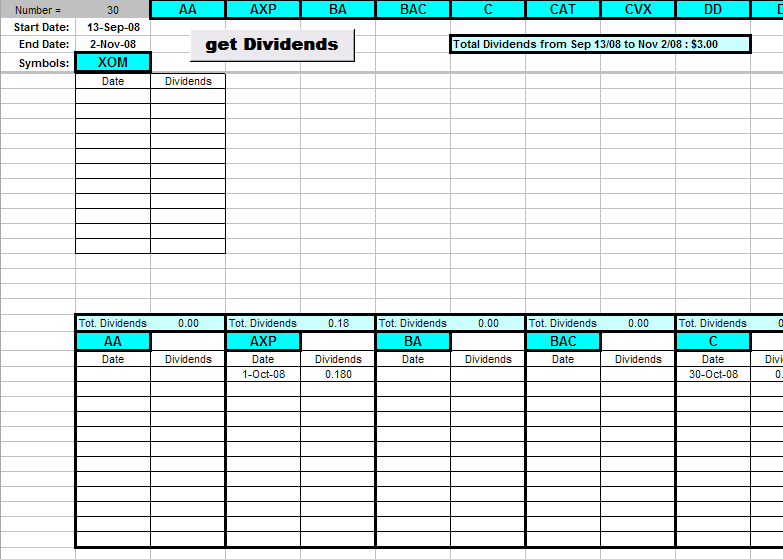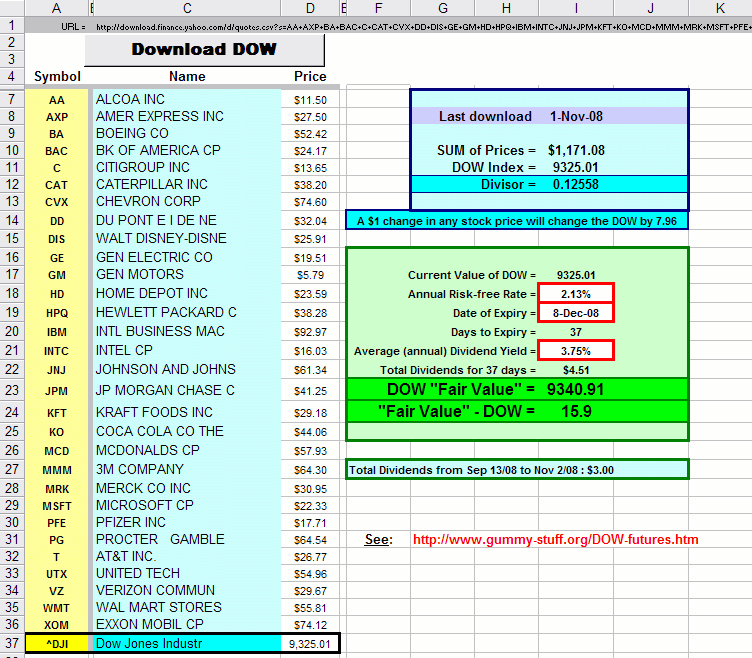| DOW futures |
Every morning, before the local stock market opens, I check the futures ... in particular, the DOW futures. However, I realized that ...
>What's a DOW future?
That's exactly what I asked myself! I realized that I didn't know what they were! 
So I surfed the Net a bit. 
Here's what I found:
- Suppose the current DOW index is at 8750.
- You buy one DOW future and it'll cost you $87,500 ... that's 10 times the current value of the DOW index.
- The futures contract has an expiry date.
- Whatever the DOW index is, at that date, that's what you'll get for your future contract ... multiplied by 10.
If the DOW is at 8635, you'll get $86,350 ... and you lose a bundle.
If the DOW is 8942, you'll get $89,420 ... and you make a bundle.
|
>Why would you buy a DOW future?
Well, you can always buy a mutual fund that tracks the DOW ... or you can buy all 30 stocks in the DOW. These futures contracts are another way of trading the DOW. They're like Options for the DOW. 
They are offered by the Chicago Board of Trade. >And the multiplier is always 10?
|
|
However, unlike Options (which give the purchaser the right, but not the obligation, to buy), the buyer is obligated to buy.
At Expiry, a Special Opening Quotation is calculated and money (not stocks!) changes hands.
>But them futures are worth a fortune! Who can afford ...?
Actually, you can buy a DOW future with just, say, $6750. That's a HUGE leverage.
It's about 4% to 7% of the value of the contract.
If you were to buy all 30 stocks on the DOW, you'd have to put up (about) 50% of the price.
At the end of each day, gains (or losses) are credited to futures accounts. If your account balance drops below the margin, you'll have to add $$$.
>So you can make a fortune!
Or lose a fortune. 
Indeed, futures trading was halted on October 24, 2008, to stem panic selling. Moscow shut for business altogether.
However, since DOW futures start trading about an hour before the market opens, I can just ...
>You can take a peek to get an idea of how the DOW will move, when the market DOES open.
Yes ... but ...
| Dividends and "Fair" Value |
There's another thing that I didn't know until I got e-mail from Tieum W.
DOW futures are an alternate way to invest in the 30 stocks of the DOW.
However, if you had bought all 30 stocks in the DOW, you'd get all the dividends.
If you buy DOW futures, you get NO dividends.
Hence the "price" of the future is reduced to account for the series of dividends ... until the futures contract expires.
>And how do you do that?
Uh ... give me some time to find out . 
Above, we said the futures contract was 10 times the current value of the DOW index.
Actually, if the DOW Futures are trading at, say, 8750, you'd pay 10x8750 for the contract.
In other words, it's 10 times the current value of the DOW Futures
... not 10 times the value of the DOW Index. 
Okay, here's how things work (I think):
- At one time, the DOW was the simple, garden variety average of 30 stock prices: (P1 + P2 + ... + P30)/30
But, over time, the set of 30 changed (some were replaced by others)** and there were stock splits (so prices doubled or tripled) etc.
so the number 30 got changed so that the Index wouldn't have a discontinuity. - The magic divisor is now quite different:
As I write this, the sum of prices is $1171.08 and the DOW Index is 9325.01 so
9325.01 = 1171.08/d, so
d = 1171.08/9325.01 = 0.12558 - That means that, for a $1 change in any stock price, the DOW will change by 1/d = 1/0.12558 = 7.96.

>What's that got to do with DOW futures?
Patience. I'm getting there.
- Suppose you had bought all 30 stocks in the DOW.
In fact, suppose you had bought 7.96 shares of each.
You'd have paid 7.96(P1 + P2 + ... + P30) = 7.96(1171.08) = 9325.01.
Very clever. Now, pay attention:
- Suppose we consider a modest, annual risk-free rate of growth for the stock prices ... say r. (For a 2.5% rate, we'd set r = 0.025.)
- That implies a daily increase of r/360.
- If you held these stocks for T days, then ...
There are 360 degrees in a circle.

I'm regurgitating what I read at the CBOT site. You can't argue with them. They're the boss.
Anyway, let me continue:
- If you held these stocks for T days, then your stocks would be worth (Today's DOW)(1+r T/360).
If, instead of the 30 stocks, you held a DOW future, it'd also be worth (Today's DOW)(1+r T/360)
... except that you wouldn't get the dividends! - The "Fair Value" for the DOW future would then be:
(Today's DOW)(1+r T/360) - (T days worth of dividends)
Note, too, that at expiry, T = 0 so the Fair Value is just the Index "Cash Value" ... less all the dividends.
I'm told that, to get a theoretical Index "Cash Price" today (rather than at expiry), some investors just add a bunch of dividends to the current Index..
>Yeah, so what's the sum of T days worth of dividends?
Note that the average dividend yield for the 30 DOW stocks (might be!) available here (?)
I guess one could use the daily yield (= annual/360) multiplied by T.
In any case, the difference between the "Fair Value" and the actual DOW is given at the CBOT site.
CBOT also gives the current trading price of DOW futures, here.
>Don't you have a spreadsheet?
Uh ... yes, and it looks like this: (Click on the picture to download the spreadsheet.)
>So, they're worth 9340.91?
Uh ... well, that's the "Fair Value". The actual trading value changes a lot, minute-to-minute. For example:

See? They traded at anywhere from 9090 to 9425, then closed at 9298.
Of course, Fair Value depends upon what you use for that risk-free rate, r.
Maybe it's some LIBOR rate, maybe it's some treasury rate. Who knows?
>And you know what you're talking about?
I never said that! 
>But suppose I'm willing to pay more than that "Fair Value"? Who'll stop me?
Nobody. Indeed, somebody will be very happy to sell you a future which is significanlty greater than the Fair Value.
Then that fella could go out and buy the 30 DOW stocks and make a killing.
>Uh ... so if the futures deviate much from Fair Value, investors will switch to the 30 stocks, right?
Or they'll sell their basket of 30 stocks and switch to the futures.
That arbitrage (taking advantage of the imbalance) keeps the DOW futures close to Fair Value.
>So you'd advise me to invest in these futures?
I never said that! 
Note:
If it helps, the spreadsheet also has a sheet that'll download a bunch of dividends. You just click a button.
It looks like this:
 |

